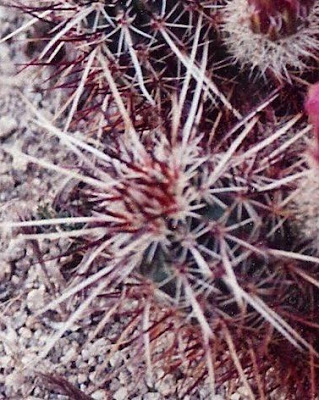The hedgehog cactus is cylindrical, or cucumber shaped,
and can be in clumps of a few to many cucumber shaped cacti.
They have a green stem, are up to a foot long and 1 to 1 1/2 inches thick. Their central spines are straight or slightly curved and one to two inches long.
Smaller radial spines are below the central spines at a sharp angle.
There are many different species of hedgehog cacti. They all have beautiful cup-shaped flowers: some are scarlet red (the one below was found near Mission Creek in the San Bernardino Mountains),
some are pink (the one below was found in Grass Canyon in Organ Pipe Cactus National Monument),
and some lavender (the one below was found in the San Felipe Hills).
They get the name claret cup cactus from the cup-shaped flowers.
and
The flowers are the first cactus to bloom in the spring, the reason that I see them bloom more than any other, because that is when I am usually in the desert, from April through June, from low to higher elevations.
The flowers last three to five days and stay open at night, unlike many other cacti species.
Some Indians collected the flower stems, burned off the spines, mashed them, added sugar and baked sweet cakes.
The hedgehog cacti are found from 3,000 to 7,950 feet in elevation (those below were found in Joshua Tree National Park).
They have a waxy coating which helps to minimize water loss, as do the spines, which provide some shade as well as deter animals from eating them. They are also able to live at higher elevations because their stems are so close together that they can minimize heat loss.
On May 29, 2010, I was in the Colorado Desert off the Hayfield Road exit of the I-10. I encountered numerous hedgehog cactus with ripe fruit.
A closeup of the fruit.
I found one that had been punctured and the inside looked much like the inside of a dragon fruit or red pitaya, which is the fruit of a cactus.
So I decided to eat some. Using a pocketknife, I cut off the outer skin, including spines, and tasted the cool sweet inside fruit.
The seeds are crunchy, like sesame seeds, but the fruit itself is very refreshing and sweet.


















is it not pitaya?
ReplyDeleteNo, it is not pitaya or dragon fruit, although the inside does look and taste similar, but this is substantially smaller.
Delete